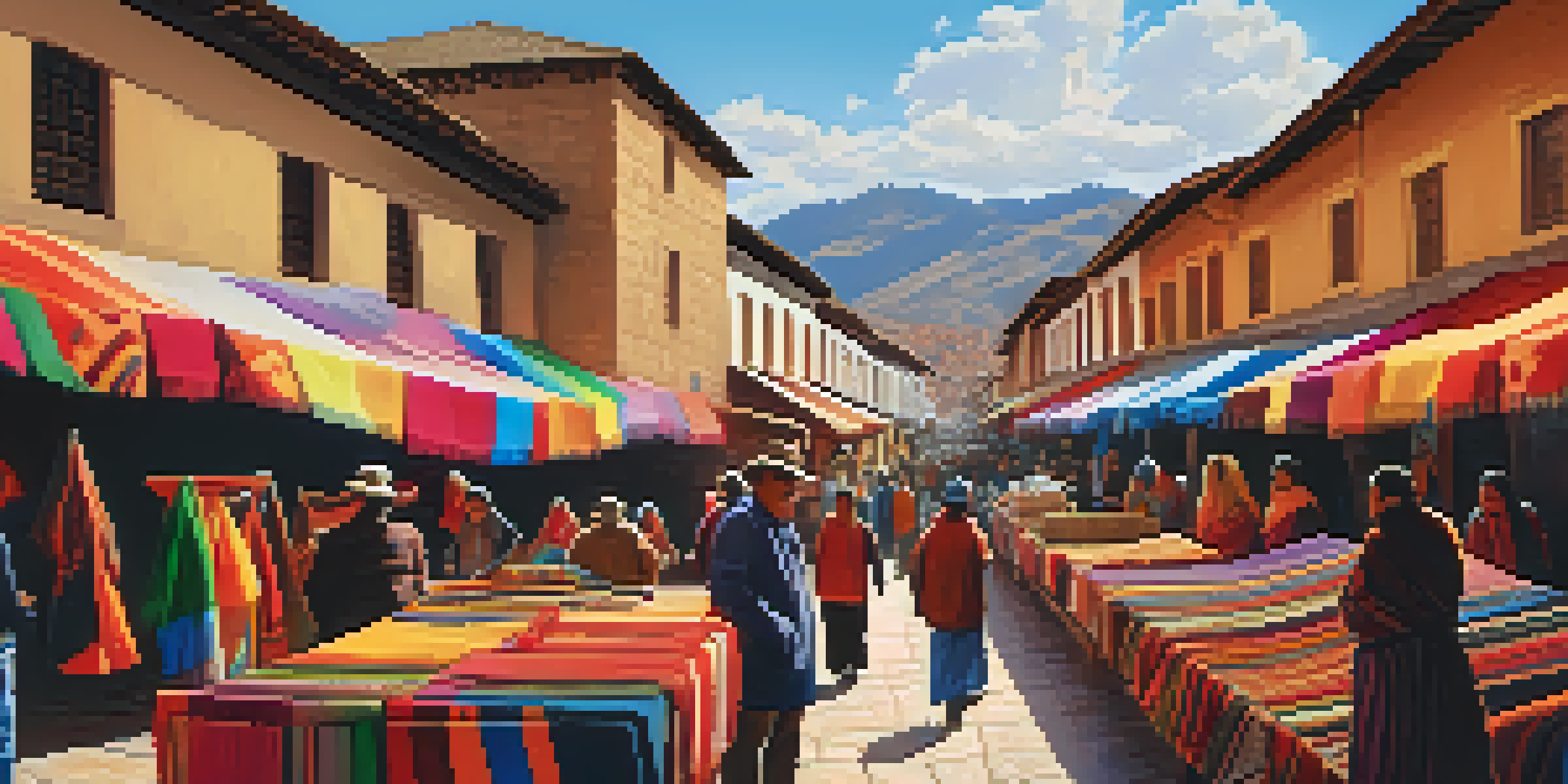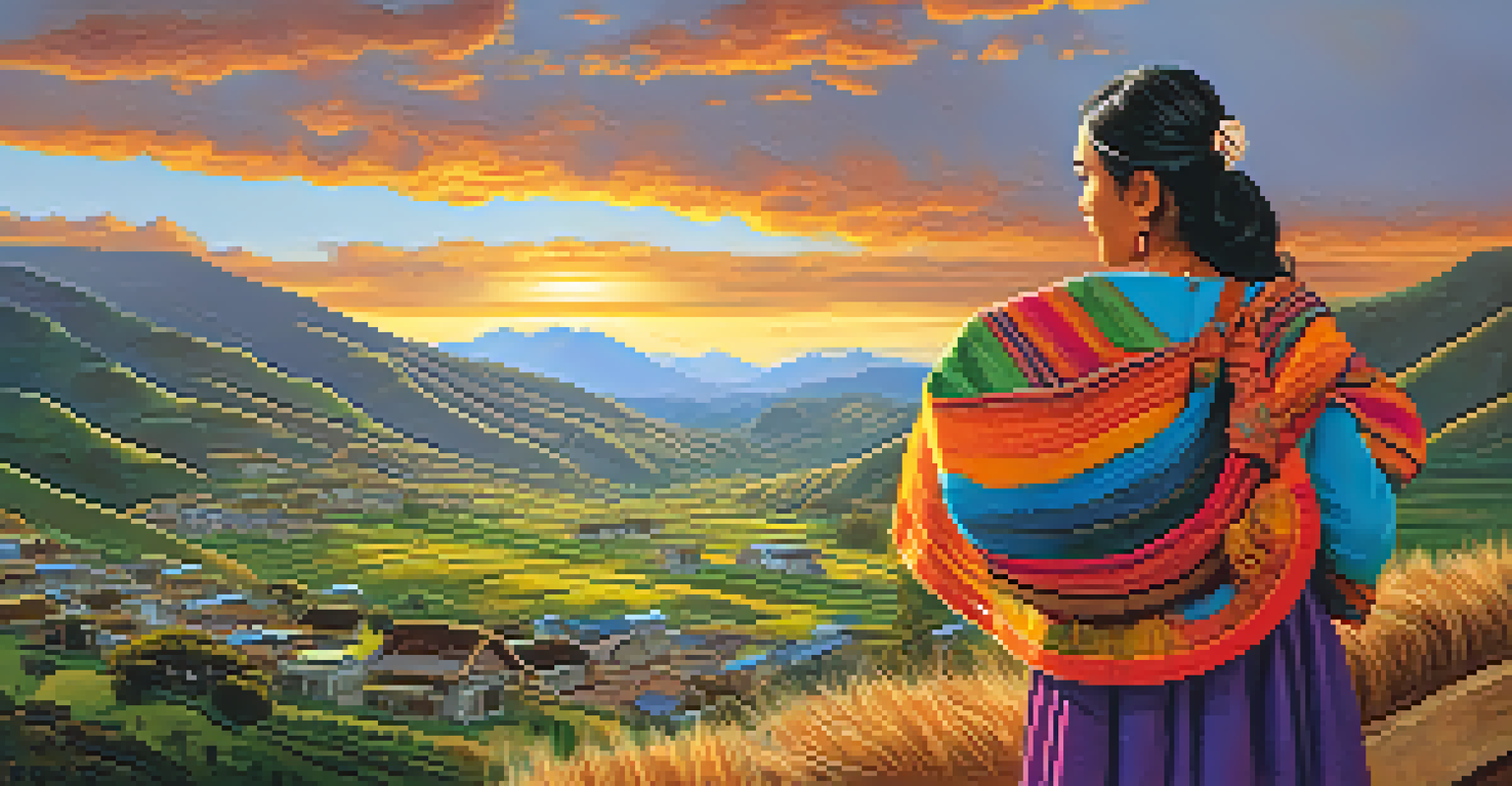A Guide to Peruvian Textile Artisans and Their Craft

The Rich History of Peruvian Textile Artisans
Peruvian textiles are not just fabric; they are a tapestry of history and culture. Dating back thousands of years, indigenous communities have woven their stories into vibrant textiles. Each piece reflects the unique traditions and beliefs of the various regions, showcasing a diversity that is both rich and profound.
Textiles are a reflection of culture, a record of history, and a bridge to the future.
The craft of weaving is deeply ingrained in the Peruvian identity, often passed down through generations. Artisans use techniques and patterns that have been refined over centuries, creating textiles that tell the tales of their ancestors. From the Inca civilization to modern-day artisans, this craft remains a vital expression of cultural heritage.
Understanding the historical context of these textiles enhances our appreciation for the artistry involved. It's not merely about creating beautiful pieces; it's about preserving a way of life and connecting with the past. Each artisan's work contributes to a larger narrative that celebrates Peru's vibrant history.
Materials and Techniques Used in Textile Art
Peruvian artisans utilize a variety of materials to create their textiles, with wool from llamas and alpacas being the most prominent. These natural fibers are not only warm and durable but also eco-friendly, aligning with sustainable practices. The vivid colors often come from natural dyes, derived from plants, minerals, and insects, adding depth and character to each piece.

Techniques such as backstrap weaving and tapestry weaving are common among artisans. Backstrap weaving, a traditional method, involves a simple loom that allows weavers to create intricate designs while maintaining a close connection to their craft. Tapestry weaving, on the other hand, allows for more complex patterns, resulting in stunning visual narratives.
Cultural Heritage in Textiles
Peruvian textiles are a vibrant reflection of the country's rich history and cultural narratives.
These methods are more than just techniques; they are a reflection of the artisan's skills and creativity. By combining traditional materials and modern innovations, artisans continue to evolve their craft while honoring their heritage.
Regional Variations in Textile Artistry
Different regions of Peru boast unique textile styles, each with its own distinct patterns and colors. For instance, the highlands, such as Cusco, are known for their bold colors and geometric designs, while the coastal areas may feature more subdued tones and intricate motifs inspired by marine life. This diversity adds to the richness of Peruvian textile art.
Art is the most beautiful of all lies, and textiles are a way to express our deepest truths.
Each community has its own stories and symbolism woven into their textiles, often representing local myths and traditions. For example, the Quechua people might incorporate symbols that reflect their connection to nature, like mountains and rivers, while other regions may focus on agricultural themes. This variety allows for a fascinating exploration of cultural identity.
Understanding these regional differences not only enhances our appreciation for the craft but also helps to promote and preserve these unique traditions. When we celebrate these differences, we support the artisans and the communities they represent.
The Role of Women in Textile Artisanship
Women play a crucial role in the world of Peruvian textiles, often being the primary artisans in their communities. This craft is not just a means of livelihood for them; it is a source of empowerment and identity. Women pass down skills to their daughters, ensuring that the art form continues to thrive.
In many cases, these artisans form cooperatives that allow them to share resources and market their products more effectively. This collaboration fosters a sense of community, where women support one another in their craft and business endeavors. Through this, they also contribute to their family's income and improve their quality of life.
Women Empowerment through Craft
Women artisans play a vital role in preserving textile traditions, fostering community support, and enhancing their families' livelihoods.
Highlighting the contributions of women in textile artistry emphasizes the importance of gender equality in traditional crafts. By recognizing their efforts, we can better appreciate the intricate stories woven into each piece and the resilience of these artisans.
The Influence of Modern Trends on Traditional Textiles
As global fashion trends evolve, Peruvian textile artisans are finding ways to blend traditional techniques with contemporary styles. This fusion creates unique pieces that resonate with both local and international markets. By embracing modern aesthetics, artisans can reach a wider audience while staying true to their roots.
Social media platforms have also played a significant role in bringing attention to Peruvian textiles. Artisans can showcase their work online, connecting with customers worldwide and sharing the stories behind their craft. This visibility helps preserve the art form while allowing artisans to thrive economically.
However, this blending of old and new can be a double-edged sword. While it provides opportunities, it also raises questions about authenticity and cultural appropriation. It’s essential for consumers to engage with these artisans respectfully and support their efforts to maintain their cultural heritage amidst changing trends.
Sustainable Practices in Peruvian Textile Art
Sustainability is a key principle in the world of Peruvian textile art. Many artisans prioritize eco-friendly practices by using natural materials and dyes, which not only benefit the environment but also enhance the quality of their products. This commitment to sustainability allows artisans to create beautiful textiles without compromising the planet.
Moreover, sustainable practices extend beyond materials. Many artisans are adopting ethical labor practices and supporting fair trade initiatives. By ensuring that they and their communities benefit from their craft, artisans contribute to a more equitable economy while preserving their cultural identity.
Sustainability in Textile Practices
Many Peruvian artisans prioritize eco-friendly materials and ethical labor practices, contributing to a more sustainable fashion industry.
Supporting sustainable artisans means investing in a future where traditional craft continues to thrive. By choosing to purchase handmade textiles, consumers can contribute to the livelihoods of these artisans and promote a more sustainable fashion industry.
Where to Find Authentic Peruvian Textiles
If you're looking to purchase authentic Peruvian textiles, there are several avenues to explore. Local markets in Peru, such as those in Cusco and Arequipa, offer a treasure trove of handmade textiles directly from artisans. Engaging with these local markets not only supports the artisans but also provides a firsthand experience of the culture.
Online platforms, such as artisan cooperatives and ethical marketplaces, have made it easier to find authentic pieces from Peru without traveling. These platforms often tell the stories behind each item, connecting consumers with the artisans who created them. This transparency adds value to the purchase and fosters a greater appreciation for the craft.

When shopping for textiles, look for certifications or labels that indicate fair trade practices. Supporting artisans through ethical purchasing not only helps preserve traditional crafts but also empowers communities to continue their artistic legacies.